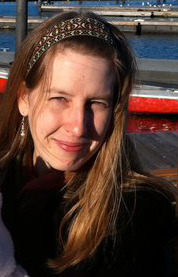Getting Over Particle Physics at Badaling
Contributor’s Marginalia: Kathryn Nuernberger on “At Badaling” by Matthew Thorburn
For reasons involving Plato, Breton, Coleridge, and the year in college I spent getting high and cultivating my beginner’s mind, I am suspicious of metaphors. I have said this before, in a poetry workshop, for example, and there is always a long silence afterwards, as if we are watching my transgression fall into a black hole.
Within his dialogues, Plato proposes “all poetical imitations are ruinous to the understanding of the hearers” (The Republic, Book X). He’s worried about the passions poems stir. I’m worried about how far we already are from every drachma we would touch and every smith or philosopher we would know. I’m worried about how electrons are streaming through us, so our bodies are remade at a rate unimaginably faster than once every seven years. I’m worried about how the Pauli exclusion principle prevents electrons from touching, so the sense we can sense at all is a mystery or an illusion. I’m worried that particle physics is a metaphor for my passions, so you can’t believe a word of my science.
In Matthew Thorburn’s poem, “At Badaling,”
The sun bears climb a jungle
gym of rusty pipes
in a cracked concrete pit.
They rise above tumbleweeds
of hair. Their dingy fur hangs
loose as old brown dressing
gowns. They have no names.
I’m worried about the bears.
I saw a sun bear in a zoo once. It was strange how it paced back and forth relentlessly on a log the length of my desk. I wished it would look at us, but it would only look to the end of its log. My husband worked as a zookeeper in medium-hoofed stock, so he could explain this was a kind of madness lonely and under-stimulated animals suffer in captivity. And now the zoo was nothing but the elephant pushing his forehead into a fake rock cliff, watching his own trunk swing a metronome for as long as I could stand to watch and then after. It was a single sea lion swimming and swimming the same elliptical track of tank. I used to love going to the zoo because each animal was a metaphor for an ecosystem I could only imagine and alternative perceptions of reality I could only imagine imagining.
The IUCN lists the sun bear as a vulnerable species. Development and deforestation has made a patchwork of their range in southeast Asia. It is suspected in the past three bear generations their population has declined by 30%. I’m worried that Thorbun’s bears are not even bears at all, but metaphors for a speaker’s passions
…in the shadow
of the Great Wall. Angry,
bigger, a bit holier than thou –
And I’m worried that the speaker is not anyone at all, just a metaphor for me and how I sometimes think outrage is superior to appreciation.
I am suspicious of metaphors because I want to perceive sun bears as they are, because if I can do that, it will be a metaphor for how I can also perceive juniper berries and honky tonk and tuna salad and my husband’s sweet face without it streaming or excluding away. It will mean that even though words themselves are metaphors for what cannot be said, a poet can say it anyway. He can say,
…I felt the hot blush
of embarrassment at how
fun it is to throw cucumbers
to half-blind bears and see
them snapped up in mid-air
and when I touch the page, the cucumbers are there and so are the bears and so is the crisp, green happiness of that moment I never felt until Matthew Thorburn wrote I did.
—Kathryn Nuernberger
 Kathryn Nuernberger is the author of Rag and Bone, which won the 2010 Elixir Press Prize. She is an associate professor of English at University of Central Missouri, where she also serves as Poetry Editor for Pleiades. New poems have recently appeared in West Branch, Nimrod, and at Versedaily.com. Her poem, “Birds of Ohio,” appears with Matthew Thorburn’s “At Badaling” in 32 Poems 10.2.
Kathryn Nuernberger is the author of Rag and Bone, which won the 2010 Elixir Press Prize. She is an associate professor of English at University of Central Missouri, where she also serves as Poetry Editor for Pleiades. New poems have recently appeared in West Branch, Nimrod, and at Versedaily.com. Her poem, “Birds of Ohio,” appears with Matthew Thorburn’s “At Badaling” in 32 Poems 10.2.



